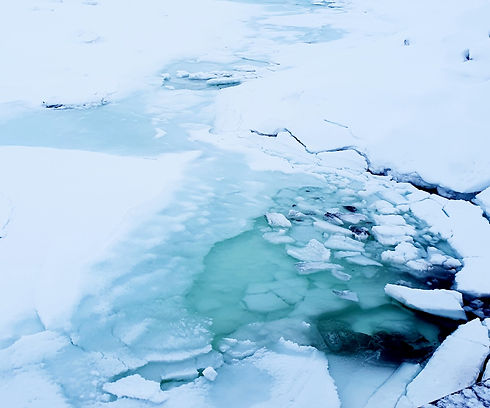Summary of Points
Speed of re-icing: We are planning to create new ice at a speed which is compatible with the natural ice accretion: the average will be around 10cm depth per week, in any area to re-ice, over a period of 2 weeks. This will be done by flooding and freezing the snow layer. The rest of the extra ice accretion (average of 70cm) occurring below the sea ice is stimulated by the additional conductivity of the top layer, which will happen over the remaining part of the winter, typically at less than 5cm per week of extra ice. This is biomimicry - we are just accelerating a totally natural phenomenon.
Area being re-iced: At any point in time, over a 2-week cycle, in the earlier part of winter, we will re-ice less than 2% of the Arctic Ocean (roughly 1.4 x 10^6 km2 over a period of 12 weeks, so on average 0.23 x 10^6 km2 every 2 weeks).
Time to distribute heat: This means that there’s plenty of time for the latent heat to be distributed in the atmosphere by winds, in the Arctic Ocean, the broader Arctic region, and beyond, without creating any major shocks to nearby areas.
Re-icing during the cold season: The re-icing operations, conducted by flooding the snow layer on top of the ice, will be conducted at the beginning of the winter season, when temperatures are already very low, and well below freezing. Local temperature changes will be insignificant. (1)
Latent heat rebalances: The creation of extra ice because of re-icing will create extra ice melting during the summer months, over the following years, when the latent heat exchange works in reverse, cooling the atmosphere, and contributing, marginally, to more stability of glaciers and permafrost in the region.
Extra Cooling in the summer: Creating extra ice in the winter is essentially restoring the conditions experienced in prior decades, when longer cold seasons were naturally contributing to thicker ice. We are recreating a neutral balance between ice creation and ice melting, reverting the scenario of the past 30 years where the melting part started to be more predominant, with a significant trend of losing sea ice volume, year after year.
Improving the Earth Energy Balance: The result of re-icing is that the sea ice will survive longer during the warmer months, and therefore improving the Earth energy balance, due to the sea ice and snow albedo effect, which will reflect significantly more sun radiation back to space. This will reduce the amount of energy absorbed by the ocean and slow down sea ice loss while also cooling the planet. This permanent effect is much larger than the transient effect of latent heat. (2)
Detailed Calculations:
Practical example of latent heat: Freezing the snow layer of 1 km2 of sea ice over 2 weeks.
(1) Latent Heat
-
Sea ice area: 1 km2
-
Snow depth: 20 cm
-
Snow density: 250 kg/m3
-
Water requirement: 15 cm of water depth = 150,000 m3 of water (~150 x 10^6 kg)
-
Duration: 2 weeks
Every kg of sea ice will generate 80 kcal of latent heat.
Total latent heat = 150 x 10^6 kg x 80 kcal/kg = 12 x 10^9 kcal = 13.9 GWh
If we assume that the latent heat will be distributed across the troposphere, up to 10,000m height and that the Arctic areas re-iced over any 2-week period are less than ~2% (about 1.3m km2 over 12 weeks) i.e., for every re-iced area there are at least 50x areas not being re-iced in the Arctic Ocean alone.
-
Average air density (first 10,000m of atmosphere) = 0.8 kg/m3
-
Re-icing area = 2% of the Arctic Ocean in any 2-week period
The air volume that can absorb the latent heat from 1 km2 of sea ice would be on average:
50 x 10^10 m3, for a weight of 400 x 10^9 kg
It takes 0.279 Wh to heat 1kg of air by 1C.
Our latent heat (13.9 GWh) would heat this volume of air by an average temperature of:
T = 13.9 GWh / (0.279 Wh/kg C x 400 x 10^9 kg) = (13.9 GWh / 111.6 GWh) C = 0.125C
This is rather insignificant during the cold winter season, and the same temperature change will be experienced, in the direction of cooling, during the summer months, due to extra sea ice melting.

(2) Energy Balance
Considering that the average increased albedo effect of sea-ice and snow cover in the Arctic Ocean compared with the open ocean corresponds to about 25 W/m2 (averaged over the entire year), we have that:
Mean reduced energy absorption for 1 km2 = 25 MW x 365 x 24h = 219 GWh
Every year, 1 km2 of sea ice improves the Earth's energy balance (permanent effect) by nearly 16 times the transient effect of latent heat (warming in the winter, cooling in the summer).

